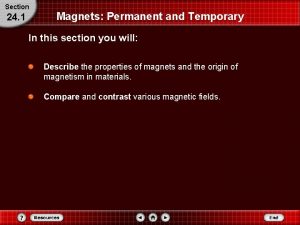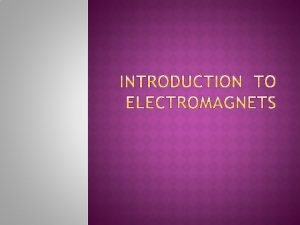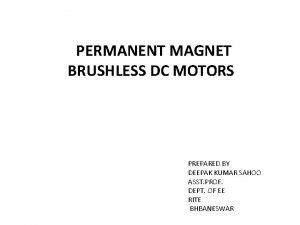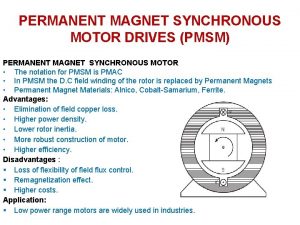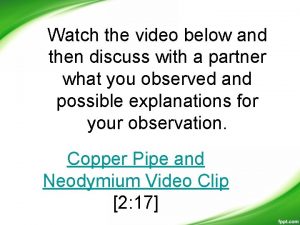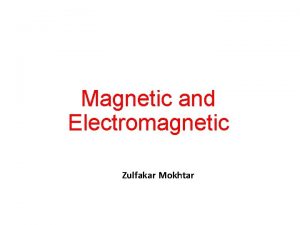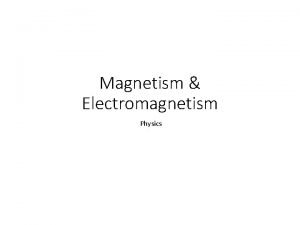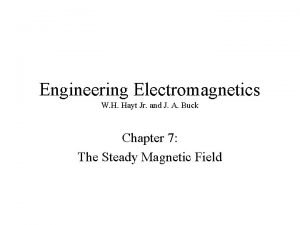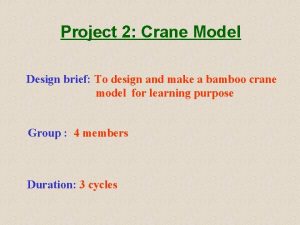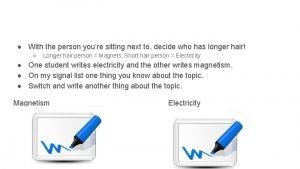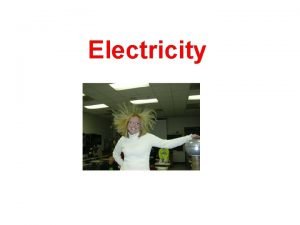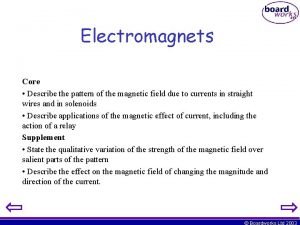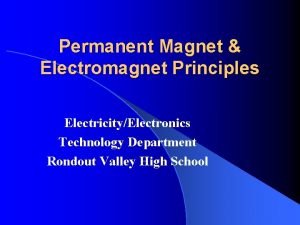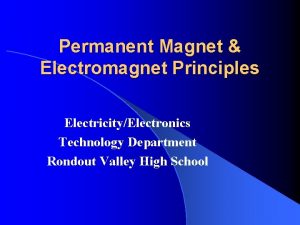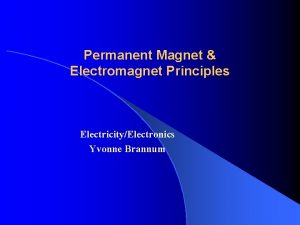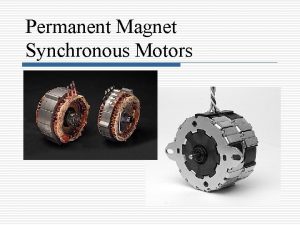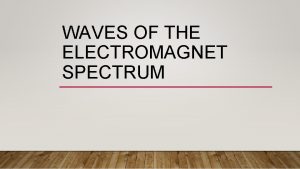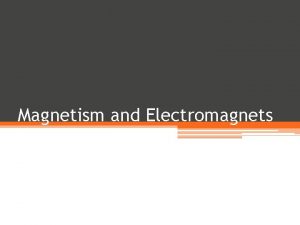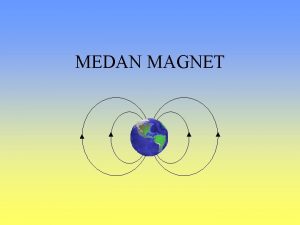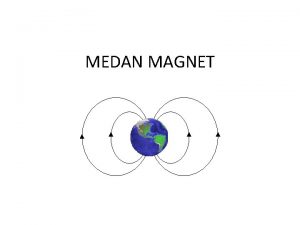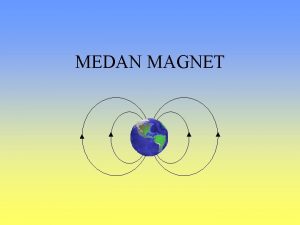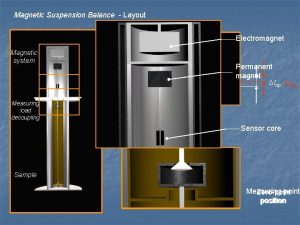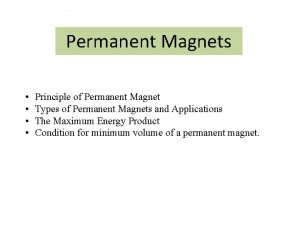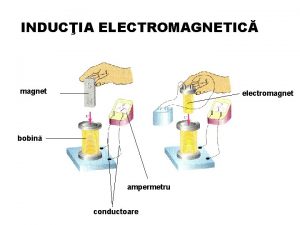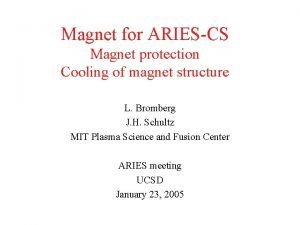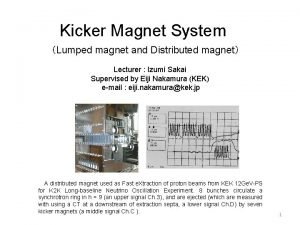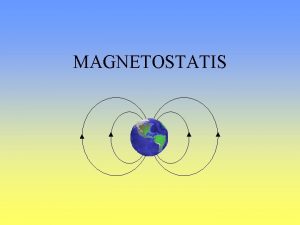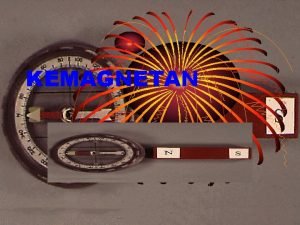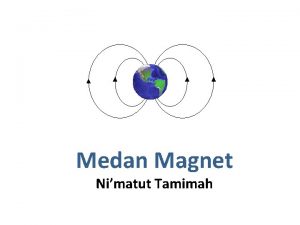Permanent Magnet Electromagnet Principles ElectricityElectronics Technology Department Rondout



















- Slides: 19

Permanent Magnet & Electromagnet Principles Electricity/Electronics Technology Department Rondout Valley High School

Outline l Permanent Magnets – Poles – Magnetic Fields – Characteristics of Fields – Uses l Electromagnets – How they are created – Magnetic fields – Uses

Permanent Magnets l Holds a magnetic force l Can not be turned on and off l Uses – Frig Magnet – Speakers – Electric Motors – Many more….

Magnetic Poles l Refers to the ends of a permanent magnet, either North or South l Determined by its charge (placement of electrons) Permanent Magnet S N

Magnetic field: l The region around a magnet or currentcarrying body in which magnetic forces are observable Permanent Magnet S N

Repelling Forces l Like S Poles want to repel each other N N Magnetic fields collide and push against each other S

Electromagnets l Use electricity to create a magnetic field l They can be controlled (turned on and off) l Their force or strength of field can be controlled

Electromagnet Basics l Current-Carrying Wire l Needs to have electron flow Electromagnetic Field around a wire

Determining the Direction of the Magnetic field l Left-Hand Rule: – Grasp a wire with your left hand with your thumb pointing in the direction of current flow – Your fingers around the wire point in the direction of the field

Creating a Larger Magnet l Coils – Each loop of coil has a small amount of magnetic pull – When the loops are added together the coil begins to act as a magnet with poles

Electromagnetic Field

Strength of Electromagnets Depends on three main things: l Number of turns in the coil – The more turns in a coil, the stronger the magnet l Amount of current in the coil – If the voltage is increased, so will the current, which will increase the strength of the magnetic field

Strength of Electromagnets(cont. ) l Permeability of the core material – Permeability: The ability of a material to be magnetized, even temporarily, and to transmit magnetic force – Air would make a weak magnet – Iron would make a strong magnet

Putting Electromagnets to Use l Solenoid: – Is an electromagnet with a moveable core called a plunger

Uses for a Solenoid l Electrical l Buzzers l Switches l Locks l Bells Relays

Solenoid Uses

Other uses for Electromagnets l Transformers l Industry l Sensors l Motors

Summary Magnets that hold their magnetic forces and can not be controlled are called_____. 1. • Permanent Magnets 2. Refers to the region around a magnet or current carrying device where magnet forces are observed. – Magnetic Field

Summary (cont. ) 3. How is the direction of a magnetic field determine around a current carrying wire? Left-Hand Rule 4. What three things determine an electromagnet’s strength? – Number of turns – Current through the coil – Permeability of core material
 Temporary vs permanent magnets
Temporary vs permanent magnets Difference between permanent magnet and temporary magnet
Difference between permanent magnet and temporary magnet Besi lunak diletakkan di sekitar magnet
Besi lunak diletakkan di sekitar magnet Blpm dc motor
Blpm dc motor Pmac drives
Pmac drives Brewbaker technology magnet high school
Brewbaker technology magnet high school Electromagnet in speakers
Electromagnet in speakers Oh magnets electromagnet
Oh magnets electromagnet Observation of electromagnet
Observation of electromagnet Equation of electromagnetism
Equation of electromagnetism Magnetism test review
Magnetism test review Electromagnet lab
Electromagnet lab Examples of electromagnets
Examples of electromagnets Magnetic field in a closed loop
Magnetic field in a closed loop Write a design brief of a crane
Write a design brief of a crane Electromagnet experiment hypothesis
Electromagnet experiment hypothesis The student sitting next to you just came
The student sitting next to you just came Currents and magnets summarizer
Currents and magnets summarizer What is electromagnet
What is electromagnet Three ways to make an electromagnet stronger
Three ways to make an electromagnet stronger
